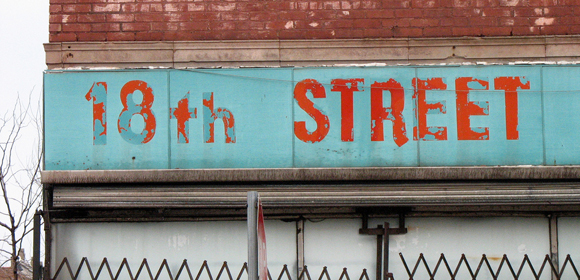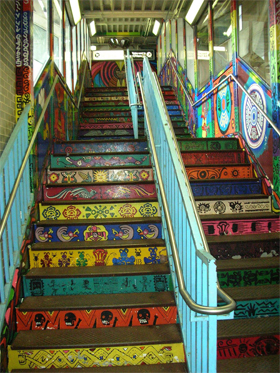
Interview with a Gentrifier
Return to page 1 | Page 2 of 4
Seeking authenticity
The notion of seeking authenticity through consumption, whether via neighborhood choice or otherwise, may seem paradoxical. However, as Holt points out, while authenticity means “avoiding contact with mass culture,” its cousin, connoisseurship, involves “reconfiguring mass cultural objects” (Holt 241). In the case of gentrification, varying degrees of rejection of the mass consumer market—from refusing to live in a condo to boycotting chain supermarkets in favor of independent corner stores—is a way in which individuals seek to find or create a society with “authenticity” in a world where sameness has become pervasive.
However, because perception of “regionalism” or “uniqueness” is subjective, there is no one true “authenticity.” Grazian suggests the concept of a “sliding scale of authenticity,” which ranges from the most commercial places and products to the most “authentic, exotic, and hip.” These objects are positioned in relation to one another according to individually manufactured definitions of “subcultural cool,” hence, the “sliding scale” (2003 72).
It is worth noting that those in a position of privilege—such as the gentrifying class—are usually those for whom the loss of authenticity, or perceived uniqueness, is a concern. Cultural elites are particularly capable of seeking alternatives to materialism, because they have typically come from social environments where material scarcity is not a concern. By seeking areas that evoke the ideas of history and community, members of the gentrifying class position themselves in opposition to other groups who are perceived as buying into impersonal materialist culture.
 Identity formation: Through oppositions
Identity formation: Through oppositions
In The Social Structure of Communities, Suttles observes that residential groups gain their identities not through their internal cohesiveness, but rather “their most apparent differences from one another” (50). Often, my interview subjects would directly compare themselves to other groups, from North Side “yuppies” to suburbanites. Their choice to live in Pilsen and its surrounding neighborhoods was in part an act of social differentiation.
When describing residents of the North Side, Chris calls them “douchebags”: “I definitely get a sense of superiority…from North Siders.” Michelle had similar responses, admitting that she has a “knee-jerk reaction” to “the sorts of people who live in condos…like yuppies, and like, stroller Nazis.” Interview subjects expressed a strong urge to set themselves apart from this group, referring to them as “rich people” with “hollow” lifestyles.
Chris, in fact, described North Siders as operating under an “alien” financial schema. In contrast, he described there being a sort of “humility” in living in a less affluent neighborhood, such as Pilsen, Bridgeport, or Logan Square.
Sid, who is originally from the suburbs of Chicago, offered a different perspective. He described the majority of the people that he grew up with as “sheltered, affluent white people” whose parents were afraid to let them into “the City”:
They just know the suburbs, they don’t know anything else. I don’t know how much of it is conscious or unconscious, but there’s an effort on my part to not be—because those people, when they do go to school, when they go to live in Chicago, it’s specific, kind of, you know, yuppie, kind of—North Side neighborhoods. And they don’t venture on the South Side at all because they think it’s big and scary. I think that very subconsciously, there is a desire to say, “I am not those suburbanites.”
Interview subjects often cited the differences they perceived between Pilsen and other, more developed neighborhoods like Hyde Park. In a university neighborhood, other people of the same demographic—mostly young, white, and middle-class—“can basically be compared to you, in a very direct way,” commented Fred. This statement seemed to reveal a sense of discomfort at one’s status and institutional affiliation being easily legible, even while on the street.
Longing for a sense of community: Spontaneous interactions and diversity
For the gentrifying class, the heterogeneity created when sharing a living space with working-class and non-white residents is another part of a perceived “authentic” urban experience, even if personal interaction with the community remains superficial. “In my neighborhood, like walking down the street, I definitely notice that I get a lot more nods and smiles from people than in any other neighborhood,” Chris said, whereas on the North Side, he felt that people just “shrug you off.”
Many people I interviewed described there being value in living in a neighborhood that they perceived to have a strong and public sense of community. “There’s like, a block party aspect to it,” Chris said. “Warmer weather, people on their stoops know each other, they gather, they have community events, the parks fill up with people who know each other.” Other comments were very similar. “I really like neighborhoods when there’s a lot of people out and walking around a lot,” said Michelle, which she compared to areas dominated by condos, where “people tend to keep to themselves a lot more.” Max told me, “There’s a lot more kids around than in a lot of neighborhoods, which is nice.”
This “block party” aspect is what Suttles calls the area’s “street life” (1968 73). Though the informal and open nature of the street creates many opportunities for spontaneous interaction, the private nature of these conversations make it difficult for new members, particularly neighborhood outsiders, to enter in long-term relationships of any depth with local residents.
“I dream about interacting with my neighbors, families that have been there for generations,” Sid said. “I’d love to be a total part of the neighborhood. But I sneak out the door and drive away, you know?” Overcoming the social “disconnect” of race, class, and age differences as a neighborhood outsider is seen as difficult, but not impossible. Sid’s choice to “sneak out the door,” Fred’s self-described shyness, and Max’s admission of feeling uncomfortable initiating social interactions with strangers are all things that could be countered by leaving one’s personal comfort zone and, as Michelle described, “being proactive” and making an effort, whether this was through making conscious efforts to be a better neighbor, or learning to speak Spanish.
